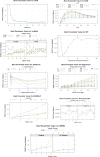The Effect of Secondary Traumatic Stress and Cognitive Flexibility on Psychological Well-Being in Health Education Students
- PMID: 40598072
- PMCID: PMC12210821
- DOI: 10.1186/s12909-025-07489-w
The Effect of Secondary Traumatic Stress and Cognitive Flexibility on Psychological Well-Being in Health Education Students
Abstract
Aim: The aim of this study is to examine the effects of secondary traumatic stress and cognitive flexibility on the psychological well-being of nursing and midwifery students and to model these relationships with machine learning approaches.
Background: While nursing and midwifery students are at risk of secondary traumatic stress (STS), cognitive flexibility is an important factor in coping with this stress. This study aims to develop strategies to improve students' mental health by examining the effects of STS and cognitive flexibility on psychological well-being using machine learning methods.
Methods: This cross-sectional descriptive study was conducted with 620 nursing and midwifery students between March and August 2024. Data were collected using a Personal Information Form, the Cognitive Flexibility Scale, the Psychological Well-Being Scale, and the Secondary Traumatic Stress Scale. Data analysis was performed using SPSS 22.0, G*Power 3.1, and R programming language 4.1.3.
Results: Hierarchical regression estimation showed that the model was significant and usable (F(2,617) = 112.473, p = 0.001). Secondary traumatic stress level and cognitive flexibility levels together explained 26.7% (R2 = 0.267) of the total variance in psychological well-being. It was determined that the decrease in students' secondary traumatic stress level (t = -7.724, p < 0.001) and the increase in cognitive flexibility level (t = 10.755, p < 0.001) caused a statistical increase in the level of "Psychological Well-Being". Shapley Additive Explanations (SHAP) were used to understand the importance and contribution of each variable in the model. Cognitive Flexibility was found to be the most important variable in the prediction of Psychological Well-Being.
Conclusions: It was determined that the decrease in the level of secondary traumatic stress and the increase in the level of cognitive flexibility caused an increase in the level of psychological well-being. Longitudinal studies on students' psychological well-being levels are recommended.
Clinical implications: This study emphasises the importance of cognitive flexibility strategies to support health education (nurse and midwife) candidates to cope with secondary traumatic stress. It may contribute to the training of healthier and more resilient professionals by increasing the psychological well-being of students in nursing and midwifery education.
Keywords: Cognitive flexibility; Machine learning; Midwifery student; Nursing student; Psychological well-being; Secondary traumatic stress.
© 2025. The Author(s).
Conflict of interest statement
Declarations. Ethics approval and consent to participate: The study was approved by Muş Alparslan University Scientific Research and Publication Ethics Committee (Date and Number: 07.03.2024–134691). After ethical approval, institutional permission (Date and Number: 21.03.2024–506507) was obtained from Van Yüzüncü Yıl University Faculty of Health Sciences, where the study will be conducted. Participants were informed in detail about the purpose and method of the study and the time required for participation. It was also emphasised that participation would not cause any harm and was completely voluntary. Verbal and written consent was obtained from the participants. The Helsinki Declaration of Human Rights was adhered to and the protection of individual rights was prioritised. Consent for publication: All authors have given their consent for publication. Competing interests: The authors declare no competing interests.
Figures





Similar articles
-
Feasibility study of Learning Together for Mental Health: fidelity, reach and acceptability of a whole-school intervention aiming to promote health and wellbeing in secondary schools.Public Health Res (Southampt). 2025 Jun 18:1-36. doi: 10.3310/RTRT0202. Online ahead of print. Public Health Res (Southampt). 2025. PMID: 40542530
-
The role of cognitive flexibility and psychological well-being in the effect of mindfulness on problematic internet use.Sci Rep. 2025 Aug 26;15(1):31373. doi: 10.1038/s41598-025-16858-w. Sci Rep. 2025. PMID: 40858699 Free PMC article.
-
Mediating role of self-efficacy and cognitive flexibility in the relationship between critical thinking and positive mental health in Turkish nursing students: a cross-sectional study.BMJ Open. 2025 Aug 8;15(8):e097631. doi: 10.1136/bmjopen-2024-097631. BMJ Open. 2025. PMID: 40780721 Free PMC article.
-
Home treatment for mental health problems: a systematic review.Health Technol Assess. 2001;5(15):1-139. doi: 10.3310/hta5150. Health Technol Assess. 2001. PMID: 11532236
-
Interventions for preventing abuse in the elderly.Cochrane Database Syst Rev. 2016 Aug 16;2016(8):CD010321. doi: 10.1002/14651858.CD010321.pub2. Cochrane Database Syst Rev. 2016. PMID: 27528431 Free PMC article.
References
-
- Mottaghi S, Poursheikhali H, Shameli L. Empathy, compassion fatigue, guilt and secondary traumatic stress in nurses. Nurs Ethics. 2020;27:494–504. - PubMed
-
- O’Callaghan EL, Lam L, Cant R, Moss C. Compassion satisfaction and compassion fatigue in Australian emergency nurses: A descriptive cross-sectional study. Int Emerg Nurs. 2020;48: 100785. - PubMed
-
- Salimi S, Pakpour V, Rahmani A, Wilson M, Feizollahzadeh H. Compassion Satisfaction, Burnout, and Secondary Traumatic Stress Among Critical Care Nurses in Iran. J Transcult Nurs. 2020;31:59–66. - PubMed
MeSH terms
LinkOut - more resources
Full Text Sources
Medical
Miscellaneous

